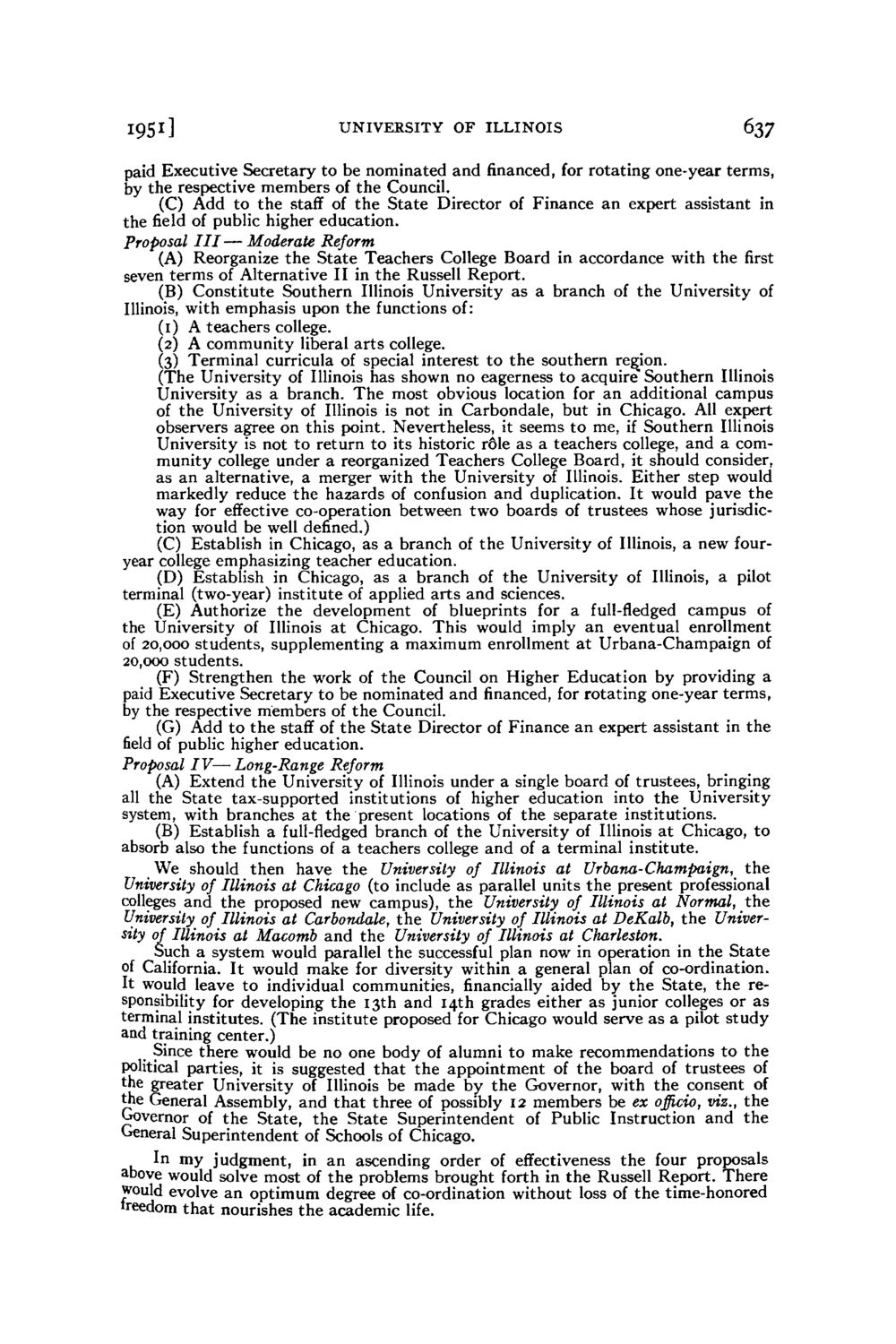| |
| |
Caption: Board of Trustees Minutes - 1952
This is a reduced-resolution page image for fast online browsing.

EXTRACTED TEXT FROM PAGE:
1951] UNIVERSITY OF ILLINOIS 637 paid Executive Secretary to be nominated and financed, for rotating one-year terms, by the respective members of the Council. (C) Add to the staff of the State Director of Finance an expert assistant in the field of public higher education. Proposal III—Moderate Reform (A) Reorganize the State Teachers College Board in accordance with the first seven terms of Alternative II in the Russell Report. (B) Constitute Southern Illinois University as a branch of the University of Illinois, with emphasis upon the functions of: (1) A teachers college. (2) A community liberal arts college. (3) Terminal curricula of special interest to the southern region. (The University of Illinois has shown no eagerness to acquire Southern Illinois University as a branch. The most obvious location for an additional campus of the University of Illinois is not in Carbondale, but in Chicago. All expert observers agree on this point. Nevertheless, it seems to me, if Southern Illinois University is not to return to its historic rdle as a teachers college, and a community college under a reorganized Teachers College Board, it should consider, as an alternative, a merger with the University of Illinois. Either step would markedly reduce the hazards of confusion and duplication. It would pave the way for effective co-operation between two boards of trustees whose jurisdiction would be well defined.) (C) Establish in Chicago, as a branch of the University of Illinois, a new fouryear college emphasizing teacher education. (D) Establish in Chicago, as a branch of the University of Illinois, a pilot terminal (two-year) institute of applied arts and sciences. (E) Authorize the development of blueprints for a full-fledged campus of the University of Illinois at Chicago. This would imply an eventual enrollment of 20,000 students, supplementing a maximum enrollment at Urbana-Champaign of 20,000 students. (F) Strengthen the work of the Council on Higher Education by providing a paid Executive Secretary to be nominated and financed, for rotating one-year terms, by the respective members of the Council. (G) Add to the staff of the State Director of Finance an expert assistant in the field of public higher education. Proposal IV—Long-Range Reform (A) Extend the University of Illinois under a single board of trustees, bringing all the State tax-supported institutions of higher education into the University system, with branches at the present locations of the separate institutions. (B) Establish a full-fledged branch of the University of Illinois at Chicago, to absorb also the functions of a teachers college and of a terminal institute. We should then have the University of Illinois at Urbana-Champaign, the University of Illinois at Chicago (to include as parallel units the present professional colleges and the proposed new campus), the University of Illinois at Normal, the University of Illinois at Carbondale, the University of Illinois at DeKalb, the University of Illinois at Macomb and the University of Illinois at Charleston. Such a system would parallel the successful plan now in operation in the State of California. It would make for diversity within a general plan of co-ordination. It would leave to individual communities, financially aided by the State, the responsibility for developing the 13th and 14th grades either as junior colleges or as terminal institutes. (The institute proposed for Chicago would serve as a pilot study and training center.) Since there would be no one body of alumni to make recommendations to the political parties, it is suggested t h a t the appointment of the board of trustees of the greater University of Illinois be made by the Governor, with the consent of the General Assembly, and that three of possibly 12 members be ex officio, viz., the Governor of the State, the State Superintendent of Public Instruction and the General Superintendent of Schools of Chicago. In my judgment, in an ascending order of effectiveness the four proposals above would solve most of the problems brought forth in the Russell Report. There would evolve an optimum degree of co-ordination without loss of the time-honored freedom that nourishes the academic life.
| |